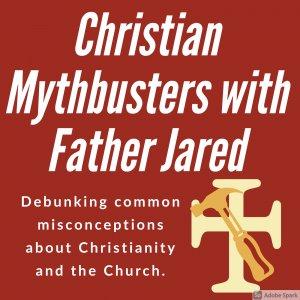Christian Mythbusters

The Myths of Thanksgiving
This is Father Jared Cramer from St. John’s Episcopal Church in Grand Haven, Michigan, here with today’s edition of Christian Mythbusters, a regular segment I offer to counter some common misconceptions about the Christian faith.
It’s Thanksgiving week, a time set aside each year to gather with family and friends and give thanks for the blessings of life. With the lockdown of last year, many chose to stay home for Thanksgiving, celebrating in smaller and safer gatherings. COVID-19 numbers in Michigan are now higher than they were back then, though, making it difficult to decide what is the best way to celebrate safely. However your family chose to celebrate, I do hope that you stay safe.
At the same time, with familiar images of Puritans and Native Americans blissfully sharing food together, this week is always a good week to bust some of the myths surrounding the origins of the Thanksgiving holiday.
Last year I suggested an excellent book for those who want to learn more about this history. It’s by David Silverman and is called This Land Is Their Land: The Wampanoag Indians, Plymouth Colony, and the Troubled History of Thanksgiving. In it, Silverman lays out much that we have learned about that original Thanksgiving, much that had been covered up by myth and historical inaccuracy. He's also clear about how the continued retelling of the Thanksgiving myth wounds not only the still existing Wampanoag Indians (and yes there are still some), but all Native people who see their history erased by quaint and invented stories.
So, let's start by clearing up a few things. First off, for at least 12,000 years, if not longer, the Native American people lived in this country, long before anyone from Europe got here. By the time the Mayflower arrived, this was not the first contact, either. There had been a century of contact between Native people and the Europeans. And it wasn’t the kind and gentle engagement of brave explorers and Native people. Instead, it was more often bloody slave raiding by the Europeans. When the pilgrims arrived, some of the Native people already spoke English and had even been to Europe and back.
I know I was taught that the pilgrims came to our country for religious freedom. These 17th century Christians were religious non-conformists who rejected the English state church of Anglican Christianity. As an Episcopalian, and a member of the Anglican Communion, that means it’s kind of my church that ran them out of England. What they wanted was a more Calvinist understanding of the Christian faith than was found in Anglicanism. So, first, they left England for Holland (where they did indeed encounter religious freedom), but then they came to America for the hope—not of religious freedom—but the hope instead of establishing a puritan colony.
You see, they were not interested in religious freedom for anyone other than themselves. They certainly rejected the religious freedom of the Native people, who they viewed as heathens. The Puritans of Massachusetts believed they were building a “city on a hill” in the words of Puritan leader John Winthrop. But there could be no dissent from their puritan views in this city on a hill. They wanted a theocracy where their own perspectives on Christianity would govern all things and all people. Roger Williams and Anne Hutchinson, members of the original Puritan community, were banished following disagreements over theology and policy. Roman Catholics were banned. Quakers were actually hung in Boston for standing up for their religious beliefs.
So, it wasn’t so much religious freedom as it was religious control.
When it comes to the Native people, the story is also very different. The specific tribe that those early pilgrims got to know was the Wampanoag people. And, true, there is evidence of a harvest feast of some sort in 1621, the year after the arrival of the Mayflower with the Wampanoag and the Puritans. But both Native people and European societies had been celebrating harvest festivals for sometime. It wasn’t until the 19th century, really, that a Thanksgiving holiday as we know it was officially established.
And that first relationship between the Wampanoag and the Puritans was actually a military relationship. The Wampanoag had reached out to the English at Plymouth in the hope of an alliance to help them in their ongoing battles against the Narragansett. You see, they had already been decimated by a pandemic (one likely brought to them by the Europeans) and this kind of relationship was one of their last hopes. And unfortunately, even if there was a shared harvest celebration at the beginning, during the next fifty years the Europeans responded by stealing Wampanoag land, spreading European disease, and exploiting their natural resources.
That Thanksgiving Myth became one of the pillars of the doctrine of Manifest Destiny, the belief that God had given American settlers the land of North America to take for their own, a doctrine that was the used to justify over a hundred years of genocide against Native people. So, our bounty came at a price.
Maybe take a moment during this holiday to reflect. Remember our history honestly. Ask how you can make right the wrongs done by those who came before you. And look for ways to break down the systems today, systems which oppress people, producing bounty only for the privileged few. I think that’s the sort of Thanksgiving that Jesus would appreciate.
Thanks for being with me. To find out more about my parish, you can go to sjegh.com. Until next time, remember, protest like Jesus, love recklessly, and live your faith out in a community that accepts you but also challenges you to be better tomorrow than you are today.






 Visit Podcast Website
Visit Podcast Website RSS Podcast Feed
RSS Podcast Feed Subscribe
Subscribe
 Add to MyCast
Add to MyCast